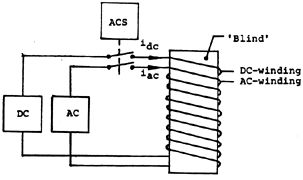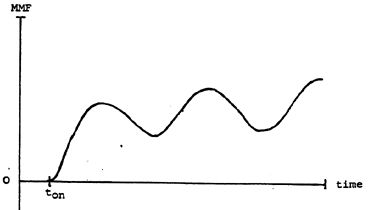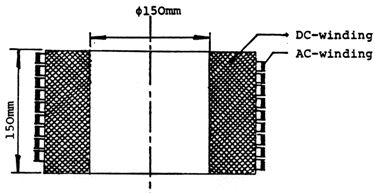by
S. Gunnar Sandberg
(School of Engineering & Applied
Sciences, University of Sussex)
June 1985
The objective of this report is to
reconstruct the experimental work carried out between 1946 and 1956 by
John R. R. Searl that concerns the geometry, materials used, and the manufacturing
process of the Sear1-Effect Generator (SEG).
The information given here is based
on private communication between the author and Searl and should be considered
preliminary as further research and development may give reason to alter
and/or update the content.
The Gyro-Cell ~
The SEG consists of a basic drive
unit called the Gyro-Cell (GC) and, depending on the application, is either
fitted with coils for generation of electricity or with a shaft for transfer
of mechanical power. The GC can also be used as a high voltage source.
Another and important quality of the GC 1s its ability to levitate.
The GC can be considered as an electric
motor entirely consisting of permanent magnets in the shape of cylindrical
bars and annular rings.
Figure 1 shows the basic GC in its
simplest form, consisting of one stationary annular ring-shaped magnet,
called the plate, and a number of moving cylinder-shaped rods called runners.
Figure 1 ~

During operation each runner is spinning
about its axis and is simultaneously orbiting the plate in such a manner
that a fixed point p on the curved runner surface traces out a whole number
of cycloids during one revolution round the plate, as shown by the dotted
lines in Figure 2.
Figure 2 ~

Measurements have revealed that an
electric potential difference is produced in the radial direction between
plate and runners; the plate being positively charged and the runners negatively
charged, as shown in Figure 1.
In principle, no mechanical constraints
are needed to keep the GC together since the runners are electromagnetically
coupled to the plate. However, used as a torque producing device, shaft
and casing must be fitted to transfer the power produced. Furthermore,
in applications where the generator is mounted inside a framework, the
runners should be made shorter than the height of the plate to prevent
the runners from catching the frame or other parts.
When in operation, gaps are created
by electromagnetic interaction and centrifugal forces preventing mechanical
and galvanic contact between plate and runners and thereby reducing the
friction to negligible values.
The experiments showed that the power
output increases as the number of runners increase and to achieve smooth
and even operation the ratio between external plate diameter Dp and runner
diameter Dr should be a positive integer greater than or equal to 12. Thus:
(1) P/Dr
= N > 12 (N = 12, 13, 14, &c)
The experiments also indicated that
the gaps O between adjacent runners should be one runner diameter D as
shown in Figure 1.
More complex Gyro-Cells can be formed
by adding further plates and runners to the basic unit. Figure 3 illustrates
a 3-plate GC consisting of three sections, A, B and C. Each section consists
of one plate with corresponding runners.
Figure 3 ~

The experiments showed that for stable
and smooth operation sections should be of equal weight. Thus:
(2) WA
= WB = WC
where
WA = weight of section
A,
WE = weight of section
E,
WC = weight of section
C.
The Magnetic Field Configuration
~
Due to a combined DC and AC magnetising
process, each magnet acquires a specific magnetic pole pattern recorded
on two tracks consisting of a number of individual N-poles and S-poles,
as illustrated in Figure 4.
Magnetic measurements have revealed
that the poles are approximately one millimetre across and evenly spaced.
It was also found that the pole density (x) --- defined as the total
number of poles N per track divided by the circumference, pi D --- must
be a constant factor specific for a particular generator. Thus:
x = Np / 3.14 Dp
=
Nr / 3.14 Dr
where Np is the total
number of poles per track on plate and N r is the total number
of poles per track on runner.
Figure 4 ~

Furthermore, the distance dr
between the two pole tracks must be the same for all runners and plates
which are parts of the same GC.
The pole tracks allow automatic commutation
to take place and create a turning moment. Exactly how this is achieved
is not understood and will require further research efforts.
Likewise, the source of energy is
at present unknown. Further research is also needed to establish the exact
mathematical relationship between output power, speed, geometry and material
parameters, such as mass density and electromagnetic properties of the
materials used.
Magnetic Materials ~
The magnets used in the original
experiments were made of a mixture of two types of ferromagnetic powders
imported from the USA. One of these magnets, still in existence, has been
qualitatively analyzed and was found to contain the following elements:
Aluminum, Silicon, Sulfur, Titanium, Neodymium, Iron. The spectrogram is
illustrated in figure 5.
Figure 5 ~

The Induction Coils ~
If the SEG is sued as an electrical
power plant a number of induction coils must be fitted to the GC. The coils
consist of C-shaped cores made of soft steel (Swedish steel) or high u-ferrite
(mu-metal). The number of turns and wire gauge used depends on the application.
Figure 6 shows the basic design.
Figure 6 ~

Manufacturing Procedure ~
The block diagram in Figure 7 illustrates
the main stages in the manufacturing process.
Figure 7 ~
(1) Selection of Magnetic
Materials >> (2) Weighing >> (3) Mixing >>
(4) Moulding >> (5) Machining >>
(6) Inspection > (7) Magnetization >>
(8) Inspection >> (9) Assembly >>
(10) Final Control.
Stage 1: Magnetic Materials &
Bonding Agents ~
It is feasible that future research
will reveal other magnetic raw materials to be cheaper and/or more efficient
than the ones used in the original experiments. It is also possible that
other types of binder may improve the performance.
Stage 2: Weighing ~
In general, to produce efficient
magnets the right amount of each element contained in the ferromagnetic
powder is crucial. It is therefore reasonable to suggest that when mixing
different types of powders an optimal weight ratio does exist that will
produce a 'best' magnet.
At present, however, this weight
ratio is not known for the powders used by Searl in his past experiments.
Together with new magnetic materials and optimization of generator geometry,
this is an area in which research efforts could be profitable.
In general, the amount of binder
used should be as small as possible to achieve maximum mass density of
bonded magnets. However, the possibility that the binder is taking an active
part in the generation of the Searl-Effect must not be excluded. For instance,
the dielectric properties of the binder may play an active role in the
electromagnetic interactions taking place in the SEG. If that is the case,
then a further amount of bonding material may be beneficial.
Stage 3: Mixing ~
The mixing is an important process
which will decide the homogenity and reliability of the finished product.
A homogeneous mixture can be achieved by using turbulent air flow inside
the mixing container The experiments did show that an improved performance
was achieved if all magnets for the same generator were made from the same
batch.
Stage 4: Moulding ~
During the moulding process the compound-
consisting of ferromagnetic powders. and thermoplastic binder is compressed
and simultaneously cured by heating. Figure 8 illustrates the tool used
for making 'blinds'. A 'blind' is an unmagnetized runner or plate/part
of plate. When manufacturing large plates (Dp > 30 cm) it may
be necessary to make them in segments rather than in one piece.
Figure 8 ~

The figures given below should be
considered as guidelines only, since correct data are not available regarding
the influence of the moulding process on the Searl-Effect.
1. Pressure: 200-400 bars
2. Temperature: 150 C-200 C
3. Compression time: > 20 minutes.
Before releasing the pressure the
mould must be allowed to cool.
Stage 5: Machining ~
This process can be bypassed if the
weighing and moulding procedures are carried out correctly. However, it
may be necessary to polish the cylindrical surface of runners and plates.
Stage 6: Inspection ~
Control of dimensions and surface
finish.
Stage 7: Magnetization ~
Runners and plates are individually
magnetized in a combined DC and AC-field during one on-off duty cycle.
Figure 9 illustrates the magnetizing circuit.
Figure 9
~

The function of the automatic control
switch (ACS) is to simultaneously switch on the DC-current, idc
and the AC current, iac at such a time, t = ton,
that the instantaneous value of the total magnetomotive force (MMF) is
always positive. Thus:
MMF = idcN1
+ iacN2 > 0
Where N1 is the number
of turns in the DC-winding and N2 is the number of turns in
the AC winding.
Figure 10 shows the total MMF as
a function of time.
Figure 10
~

The magnetization coil consists of
a DC winding containing approximately 200 turns of heavy copper wire and
an AC winding containing approximately 10 turns of copper strip wound on
top of the DC winding. Figure 11 shows a cross-section of the coil and
its dimensions.
Figure 11 ~

Recommended parameter values:
DC current, idc = 150
A to 180 A
AC current,
iac = 0.1 to 0.2 A
Frequency,
f = 1-3 MHz
Stage 8: Inspection ~
The purpose of this control is to
test for the existence of and the correct spacing of the two pole tracks.
The measurements can be made with a magnetic flux density meter in combination
with a set of control magnets.
Stage 9: Assembling ~
The assembling procedure depends
on the application. Used as a mechanical drive unit, the magnets must be
mounted inside a framework and fitted to a drive shaft. Used as an electric
power plant, induction coils must be fitted to the framework.









